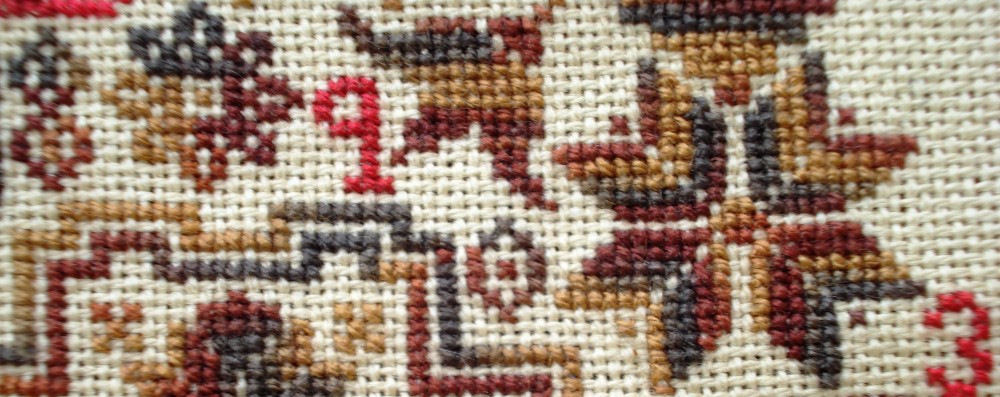There are a few stitches that challenge me more than others. And Sharon Boggon from Pin Tangle’s Take a Stitch Tuesday (TAST) has included more than one in her weekly challenges. This week in fact! The Knotted Cretan Stitch is lovely. I love the texture. I don’t love the math.
I suppose it wouldn’t be so bad if I drew lines on the fabric rather than counted threads. But the threads ARE lines so it really shouldn’t matter. Actually a basic line of Cretan (or chevron or herringbone) stitches isn’t a problem. The problem is when I try to layer them. The second layer takes a few minutes to figure out my new count and placement. But the third and fourth are killers. It feels like I’m using my left hand instead of my right. Is this a Right Brain vs. Left Brain thing? Can anyone tell me how to make this easier?
I can fold egg whites into a batter without loosing a molecule of air, but I struggle beyond belief with multiple layers of these stitches. I can take the sugar out of a recipe and make the item taste like a thousand calories. I love the texture of layered stitches. And when I look at other peoples’ work, it all seems so lovely and effortlessly layered.
I know it’s about multiples. That’s kind of like permutations—right? Could someone please write a blog about this for we mathematically challenged stitchers and send me the link? Or will this not really matter when I pull my antique crazy quilt out of storage and start the embellishments that were never done?
One thing I have learned this week with the Knotted Cretan is about when to end the thread if you didn’t start with enough. End at either far end of the stitch (A or D per Sarah’s pictorial tutorial.) Bring the new thread in at the point where the stitch will be bisected, the middle point, the C point if you use A-B-C-D notation for a stitch. If you end your thread in the middle, you have to introduce the new thread in the same space and it looks messy. Thank goodness I DID learn something. Everything else was kind of accidental! But I DO like what I did and think I could recreate it. What do you think? How would you further embellish this?
Oh, and I played with threads. This is the first weekend for picking strawberries here so I was thinking about fruity colors. Colors related to cherries for the bottom two rows. Grape and watermelon for the top two. I was going to add something for blueberry, my favorite, but pooped out. There’s a variety of silk, stranded cotton, and perle cotton in this sample. Here’s the cast in order of appearance:
- DMC Perle #5 3042
- Weeks Dye Works floss #2262 Watermelon
- Caron Wildflowers #081 Black Cherry
- Caron Waterlilies #149 Cherry Cordial


Julie
Surface embroidery is not necessarily done on a grid. It is more than OK to go off the grid. For instance you can make curving organic lines with stitches like this.
It’s been a long time since I’ve worked on something that isn’t gridded. It will be good to get my antique crazy quilt out of storage and start the embellisments. I just hope my organic doesn’t end up looking like “organic brain disease!” Thanks for the reminder. Sometimes we all just need to get out of the “box.”
While it won’t matter for your crazy quilt, if you’re still interested in handling work on evenweave fabrics, I’d like to help. One thing you didn’t specify, however, is your criteria for layering. They are a number of different ways multiple layers might be overlapped, so I’d need to know what you expect the layers to look like in relationship to each other in order to be specific.
There are basically three things that are important: what part of the stitch you’re using as the basis for placing your latyers (the spikes, the knots or the stitch’s midline), amount of offset between one basis and the next (centered or a number of threads) the axis of the offset (vertical or horizontal). For example, you might use the spikes as the basis and want to center the second layer horizontally, so that the second layer is directly on top of the first, but its spikes fall exactly between the spikes of the first layer.
I do about 90% of my work on Aida or other evenweave–I just love those grids–so if you can describe what you’re trying to achieve, I think I can help.
I’m going to have to consider this question, looking more closely at my work. I will definitely be in touch as soon as I clarify my question. Would you consider writing a guest post?
I’m flattered. I’d be happy to. I’ve written (and published) instructional articles and curriculum, so I have the technical resources I need to create whatever graphics are necessary. If you like, I’ll begin to think about a structure and send you an outline for approval. That will also give me time to develop and scan or photograph samples at various stages of development.